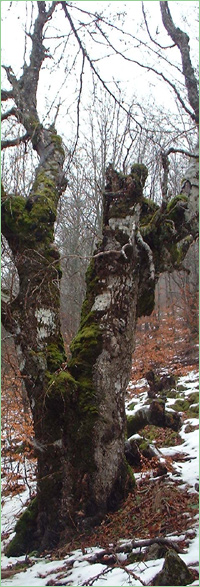Tsentralen Balkan (Unique identification code in the register: BG0000494)
Category: PZ under both Directives
Area: 72021.07 hectares Location:
1.
District: Gabrovo, Municipality: Sevlievo, Locality: Kravenik, Stokite
2.
District: Lovech, Municipality: Teteven, Locality: Divchovoto, Ribaritsa
3.
District: Lovech, Municipality: Troyan, Locality: Balkanets, Beli Osam, Cherni Osam, Chiflik
4.
District: Lovech, Municipality: Аpriltsi, Locality: Аpriltsi
5.
District: Plovdiv, Municipality: Karlovo, Locality: Hristo Danovo, Iganovo, Kalofer, Karlovo, Karnare, Klisura, Pevtsite, Rozino, Vasil Levski
6.
District: Plovdiv, Municipality: Sopot, Locality: Sopot, Аnevo
7.
District: Sofia, Municipality: Pirdop, Locality: Pirdop
8.
District: Sofia, Municipality: Аnton, Locality: Аnton
9.
District: Stara Zagora, Municipality: Pavel banya, Locality: Gabarevo, Gorno Sahrane, Manolovo, Pavel banya, Skobelevo, Tarnicheni, Tazha, Аsen
Falls in the territory of the following Regional Inspectorates of Environment and Water (RIEW):
1.
Pleven - ul."Aleksander Stambolijski"1A
2.
Plovdiv - bul."Maritsa" 122
3.
Sofiia - bul."Tsar Boris III" №136
4.
Stara Zagora - bul."Stara planina" № 2
5.
Veliko Tarnovo - ul."N.Gabrovski" 68
Ordinance for announcement:
Ordinance No.РД-559 from 05.09.2008
2-3-494-559-2008
Ordinance for change:
1.
Change in the aims with Ordinance No.РД-260 from 31.03.2021
2.
Change in the subject for conservation with Ordinance No.РД-260 from 31.03.2021
Record for protected zone (link):

Aims of the declaration:
1. Protection and maintenance of the habitats of the bird species referred to in items 2.1 and 2.2, their populations and distribution within the area to achieve and maintain their favorable conservation status;
2. Protection and maintenance of natural habitats types under item 2.3, habitats referred to item 2.4. species, their populations and distribution within the area to achieve and maintain their favorable conservation status in Alpine biogeographical region;
3. Improvement of habitats of species Alcedo atthis;
4. Increase the contribution of the protected area to the area of natural habitats with codes 6230*, 62D0, 6520, 7140 and 8110;
5. Improving the structure and functions of natural habitats with codes 3260, 6150, 6210 (* important orchid habitats), 6230*, 62D0, 6520, 8110, 9170, 91CA, 9530* and 95A0;
6. If necessary, improvement of the condition or restoration of types of natural habitats refered in item 2.1, habitats of the species refered in item 2.2 and their populations.
Objects of protection (species or habitats):
1. Article 6, paragraph 1, section 3 from Biological Diversity Act: Black Stork (Ciconia nigra), Honey Buzzard (Pernis apivorus), Short-toed Eagle(Circaetus gallicus), Long-legged Buzzard (Buteo rufinus), Lesser Spotted Eagle (Aquila pomarina), Imperial Eagle(Aquila heliaca), Golden Eagle (Aquila chrysaetos), Griffon vulture (Gyps fulvus), Booted Eagle (Hieraaetus pennatus), Saker Falcon(Falco cherrug), Peregrine Falcon (Falco peregrinus), Hazel Hen (Bonasa bonasia), Rock Partridge (Alectoris graeca graeca), Corncrake (Crex crex), Eurasian Eagle-owl (Bubo bubo), Eurasian Pygmy Owl (Glaucidium passerinum), Ural Owl (Strix uralensis), Tengmalm's Owl (Aegolius funereus), Nightjar (Caprimulgus europaeus), Common Kingfisher (Alcedo atthis), European Roller (Coracias garrulus), Grey-headed Woodpecker(Picus canus), Black Woodpecker (Dryocopus martius), Syrian woodpecker (Dendrocopos syriacus), Middle Spotted Woodpecker (Dendrocopos medius), White-backed Woodpecker (Dendrocopos leucotos), Woodlark (Lullula arborea), Tawny Pipit (Anthus campestris), Barred Warbler (Sylvia nisoria), Red-breasted Flycatcher (Ficedula parva), Semi-collared flycatcher (Ficedula semitorquata), Red-backed Shrike (Lanius collurio), Lesser Grey Shrike (Lanius minor), Ortolan Bunting (Emberiza hortulana);
2. Article 6, paragraph 1, section 4 from Biological Diversity Act: Eurasian sparrowhawk (Accipiter nisus), Common Buzzard (Buteo buteo), Common Kestrel (Falco tinnunculus), Green Sandpiper (Tringa ochropus), European Bee-eater (Merops apiaster).
3. Article 6, paragraph 1, section 1 from Biological Diversity Act: 3160 Natural dystrophic lakes and ponds;
3260 Water courses of plain to montane levels with Ranunculion fluitantis and Callitricho-Batrachion;
4060 Alpine and Boreal heaths;
4070 * Bushes with Pinus mugo;
6110 * Rupicolous calcareous or basophilic grasslands of the Alysso-Sedion albi;
6150 Siliceous alpine and boreal grasslands;
6170 Alpine and subalpine calcareous grasslands;
6210 Semi-natural dry grasslands and scrubland facies on calcareous substrates (Festuco-Brometalia) (*important orchid habitats);
6230 * Species-rich Nardus grasslands, on siliceous substrates in mountain areas;
62D0 Oro-Moesian acidophilous grasslands;
6430 Hydrophilous tall herb fringe communities of plains and of the montane to alpine levels;
6520 Mountain hay meadows;
7140 Transition mires and quaking bogs;
7220 * Petrifying springs with tufa formation (Cratoneurion);
8110 Siliceous scree of the montane to snow levels;
8210 Calcareous rocky slopes with chasmophytic vegetation;
8220 Siliceous rocky slopes with chasmophytic vegetation;
8230 Siliceous rock with pioneer vegetation of the Sedo-Scleranthion or Sedo albi-Veronicion dillenii;
8310 Caves not open to the public;
9110 Beech forests Luzulo-Fagetum;
9130 Beech forests Asperulo-Fagetum;
9150 Medio-European limestone beech forests of the (Cephalanthero-Fagion);
9170 Oak-hornbeam forests Galio-Carpinetum;
9180 * Forests Tilio-Acerion of slopes, screes and ravines;
91BA Moesian silver fir forests;
91CA Rhodopide and Balkan Range Scots pine forests;
91W0 Moesian beech forests;
91Z0 Moesian silver lime woods;
9410 Acidophilous Picea forests of the montane to alpine levels (Vaccinio-Piceetea);
9530 * (Sub-) Mediterranean pine forests with endemic black pines;
95A0 High oro-Mediterranean pine forests;
4. Article 6, paragraph 1, section 2 from Biological Diversity Act: Mammals - Ursus arctos, Canis lupus, Lutra lutra, Rupicapra rupicapra balcanica, Spermophilus citellus, Rhinolophus ferrumequinum, Rhinolophus hipposideros, Myotis myotis, Myotis blythii, Myotis bechsteinii, Miniopterus schreibersii, Barbastella barbastellus;
Amphibians and reptiles - Triturus karelinii, Bombina variegata, Testudo graeca, Testudo hermannI;
Fish - Cottus gobio, Barbus meridionalis;
безгръбначни - *Ручеен рак Austropotamobius torrentium, Lucanus cervus, Cerambyx cerdo, Morimus funereus, Rosalia alpina, Osmoderma eremita, Euplagia Callimorpha quadripunctaria, Polyommatus eroides;
Plants - Tozzia carpathica, Dicranum viride, Buxbaumia viridis, Hamatocaulis vernicosus.
Current prohibitions and regimes:
1. It is prohibited grazing of domestic animals in the areas of distribution of natural habitats with codes 6430, 3260, 7140 and 7220;
Overlapping (partial or full):
1.
National Park: Tsentralen Balkan
2.
Reserve: Boatin
3.
Reserve: Dzhendema
4.
Reserve: Kozya Stena
5.
Reserve: Peeshti Skali
6.
Reserve: Sevеren Dzhendem
7.
Reserve: Sokolna
8.
Reserve: Stara Reka
9.
Reserve: Steneto
10.
Reserve: Tsarichina

|
|

|


 Превод на български
Превод на български